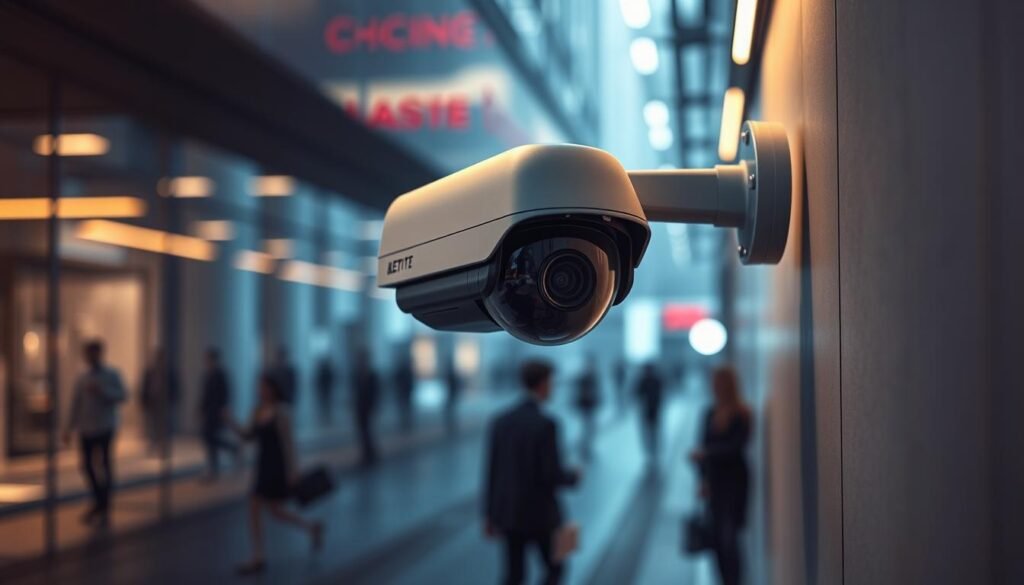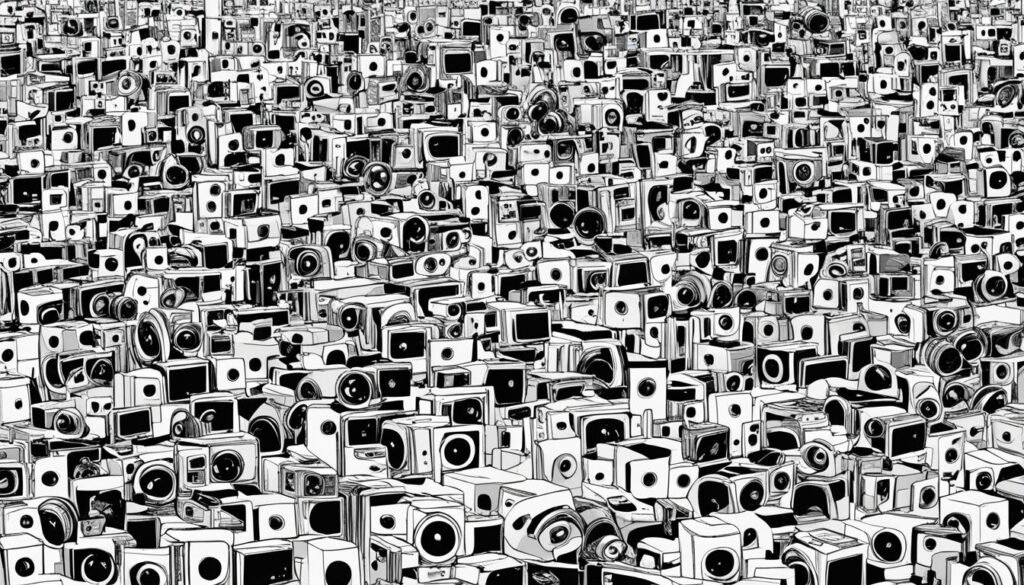Ever wondered how a tiny lens could be your watchful guardian? Motion detection cameras have changed the game for home and business security. They keep an eye out for any unexpected movement, day or night.
Recent studies show we trust these digital protectors more and more. After testing over 100 cameras and spending 5,000+ hours researching, top brands like Lorex and Nest have come out on top. Lorex scored a high 9.6/10, and Nest wasn’t far behind with a 9.2/10.
The Wyze Cam Outdoor v2 is the best for outdoor surveillance, with a 9.6/10 rating. These cameras have resolutions up to 2160p and fields of view from 110° to 180°. This means they can capture your property clearly.
Looking to protect your home or business? Motion detection cameras are a strong choice. They come with night vision, wide-angle lenses, and smart integrations. These cameras are more than just recorders; they’re your 24/7 digital security team.
Understanding Motion Detection Technology
Motion detection technology is key to modern security systems. It uses smart sensors to notice changes in the environment. This makes surveillance cameras more effective and efficient.
How Motion Sensors Work
Motion sensors in security systems act like silent guards. They check for changes and send alerts when they see movement. This technology lets cameras record only when needed. It saves storage space and makes monitoring easier.
Types of Motion Detection
There are different types of motion sensors for various needs. Passive infrared sensors look for body heat, while microwave sensors use radio waves to detect movement. Some systems use both for better accuracy. Each type has its own strengths, fitting different security needs.
Advantages Over Traditional Surveillance
Motion detection cameras have big advantages over older systems. They reduce false alarms and storage needs. Users get alerts on their phones right away when something happens. These smart cameras can cover large areas well, making them great for homes and businesses. With motion sensors, surveillance cameras become active guardians of your space.
Key Features of Modern Security Cameras
Home security cameras have evolved a lot in recent years. Today, they come with features that make it easier to protect your property. High-resolution video capture is a big change. Now, many cameras can record in 4K, letting you see every detail clearly.
Night vision cameras are now common. They use infrared technology to capture clear images in the dark. This means your property is always protected, day or night.
Wireless cameras have changed home security. They can be placed anywhere easily and set up without complicated wiring. Many connect to your Wi-Fi, letting you watch and control them from your phone.
Two-way audio is a key feature. It lets you talk to visitors or potential intruders through your camera. Outdoor cameras are also designed to withstand bad weather, protecting your property all year.
Storage options have also grown. Some cameras save footage on SD cards, while others use cloud storage. This keeps your videos safe even if the camera is lost or damaged. With new technology, cameras now have AI features like facial recognition and object tracking, making home security even better.
Choosing the Right Motion Detection Camera for Your Needs
Finding the right motion detection camera can be tough. There are many options, from indoor to outdoor and wireless security cameras. Let’s look at the main things to think about when picking one.
Indoor vs. Outdoor Cameras
Indoor cameras are smaller and have features like two-way audio. Outdoor cameras are made to withstand the weather and see in the dark. Lorex is a top choice with a SecureScore™ of 9.2/10. They offer both indoor and outdoor cameras with up to 4K resolution and long-range night vision.
Wireless vs. Wired Options
Wireless security cameras are easy to place anywhere. Some people are okay with changing batteries every few months. Solar-powered outdoor cameras are a green choice. Wired cameras always have power but might need a pro to set them up.
Resolution and Night Vision Capabilities
At least 1080p resolution means your video will be clear. Lorex goes up to 4K. Night vision is key for watching your space all the time. Many outdoor cameras have lights to help see in the dark. You can choose from fields of view like 160 and 130 degrees.
Google Nest scores 8.5/10 and has cool features like AI facial recognition. Ring is just as good, with person and vehicle detection. Think about what you need, your budget, and the features you want to find the best camera for you.
Installation and Setup Guide for Motion Detection Cameras
Setting up a DIY security system with motion detection cameras is easy. Many cameras come with step-by-step guides in mobile apps. You’ll need to mount the camera, connect it to power, and set up Wi-Fi.
Think about where to place your cameras for the best coverage. Put them high and angle them down for a wide view. Don’t point them at bright lights or shiny surfaces. Adjust the motion detection to avoid false alarms from pets or cars.
Installing cameras yourself is a common choice, but you can also hire a pro. SimpliSafe offers DIY setups starting at $125, while ADT’s professional installation is about $150. Ring Alarm has both DIY and professional options, with the professional starting at $130 through OnTech.
After setting up your camera, customize its settings. Choose how you want to be notified when motion is detected. Many systems let you ignore certain areas. With your cameras ready, you’ll feel secure in your space.
Integrating Cameras with Smart Home Systems
Smart home technology has grown a lot in eight years. Now, homeowners use many devices to make their homes smarter. Motion detection cameras are key in this, working well with other smart home parts.
Compatibility with Popular Platforms
Many cameras work with Amazon Alexa, Google Home, and Apple HomeKit. This lets users control everything from one place. For example, the Echo Show 15 lets you see camera feeds on a bigger screen.
Voice Control and Mobile App Integration
Voice control makes it easy to manage security cameras. Even though there are some issues with Google assistants, things are getting better. The Alexa app is easy to use and helps with home automation.
Automation Possibilities
Automation is not just for cameras. Smart lights, sensors, and plugs can work together to do things automatically. For example, if a camera sees motion, it can turn on the lights. Smart door locks, around €49.99, add more security and ease.
Some sensors like the Aqara FP1E need a Zigbee hub and have limits, but they can detect up to 6 meters away. As AI gets better, we’ll see systems that are smarter and less likely to make false alarms.
Privacy Concerns and Legal Considerations
Camera privacy is a big concern with motion detection cameras becoming more popular. Users must understand the legal rules about using these devices. Laws about surveillance differ by state and area, so it’s important to check local laws before setting up cameras.
Data protection is also a big issue. It’s key to use strong passwords and two-factor authentication to keep camera feeds safe from unauthorized access. Many cameras now have privacy features like geofencing and scheduling to control when they record. Some even have physical privacy shutters for extra security.
Outdoor cameras bring their own set of challenges. They might accidentally record what’s happening in neighboring areas, leading to legal and ethical questions. In the U.S., about two dozen states let cameras record school bus passing violations. This shows how surveillance is accepted for safety, but we need clear rules on how to use cameras.
The Web Scraping Services market is worth $1.5 billion and is growing fast, at 15% a year. This industry faces big privacy concerns. With new technology, finding the right balance between security and privacy is key for both camera users and lawmakers.
Motion Detection Cameras for Business Security
Motion detection cameras are now key for keeping businesses safe. They protect many types of businesses, like shops, offices, and warehouses.
Retail Loss Prevention
In shops, these cameras help stop theft. They watch over high-risk spots and work with cash registers. This helps stores track and stop theft, keeping their goods safe.
Office and Warehouse Protection
For offices and warehouses, these cameras are part of a strong security plan. They check who goes in and where they go. If someone shouldn’t be there, they alert security right away.
Integration with Access Control Systems
Today, these cameras work with systems that control who gets in. This makes a strong security network. It links video with who comes in, making it easier to solve problems and keep things safe.
Using motion detection cameras has many benefits for businesses. They help stop theft and keep workers safe. As technology gets better, businesses use these cameras more to stay secure and run better.
Enhancing Home Safety with Surveillance
Motion detection cameras are changing how we think about home safety. They do more than just traditional security. They help keep an eye on pets, offer peace of mind, and let owners interact with their pets while away.
Baby monitors with motion detection also have cool features like temperature sensing and cry detection. This means parents can keep a close watch on their babies. It’s like having an extra pair of eyes.
For families looking after elderly relatives, these cameras add an extra layer of security. They can spot falls or strange activity, helping caregivers act fast in emergencies. With prices starting at $149.99 online, they’re a smart buy for home safety.
These cameras work well with smart home systems, making them easy to control with your voice or a mobile app. You can check on your home, pets, or family from anywhere. Some cameras even use AI to tell the difference between people and things, reducing false alarms.
Advanced Features: AI and Machine Learning in Camera Systems
AI cameras are changing how we watch over things with their advanced tech. They use artificial intelligence to make security better and easier to manage. Let’s look at some cool features these AI cameras have.
Person Detection and Facial Recognition
AI cameras are great at spotting people in what they see. They can tell humans from animals or objects, cutting down on false alarms. Some can even recognize certain people’s faces. This is super useful for keeping homes and businesses safe.
Object Tracking and Zone Monitoring
These smart cameras can follow objects as they move. They let users set up areas to watch closely. If something moves in these spots, the camera alerts the owner on their phone or security system. This makes monitoring more focused on what’s really important.
False Alarm Reduction
AI in security cameras is great at cutting down on false alarms. They learn to ignore things like trees swaying or cars driving by. So, you get fewer alerts that aren’t important and alerts only when something real happens.
As AI gets better, we’ll see even more cool stuff in cameras. Things like better night vision and more accurate person spotting. These smart devices are changing how we handle security and watching over things.
Maintenance and Troubleshooting Tips for Your Motion Detection Cameras
Keeping your motion detection cameras in top shape is key for their best performance. Regularly clean the lenses, check power connections, and make sure they’re in the right spot. For outdoor cameras, check for weather damage or pests often. These simple steps help avoid common problems and make your security system last longer.
If your camera has issues, start by trying simple fixes. Reset the camera, update its firmware, and check the network connection. Over 85% of home security cameras work with smart home systems like Amazon Alexa or Google Assistant. If you’re having trouble with these, make sure your camera is compatible with your system.
Software updates are crucial for your camera’s performance and security. Keeping your camera’s firmware and apps updated gives you the newest features and security fixes. This is crucial since nearly 60% of buyers check a camera’s privacy and security before buying. Regular updates show a brand’s effort to quickly fix any security issues.
Wireless cameras are popular for their ease of use, but battery life is important. The average battery life is several months with daily use, but some models like Ring’s Outdoor 4 cam last longer. About 60% of users like wireless cameras that are easy to recharge. Think about this when placing your cameras for easy upkeep and long life.


